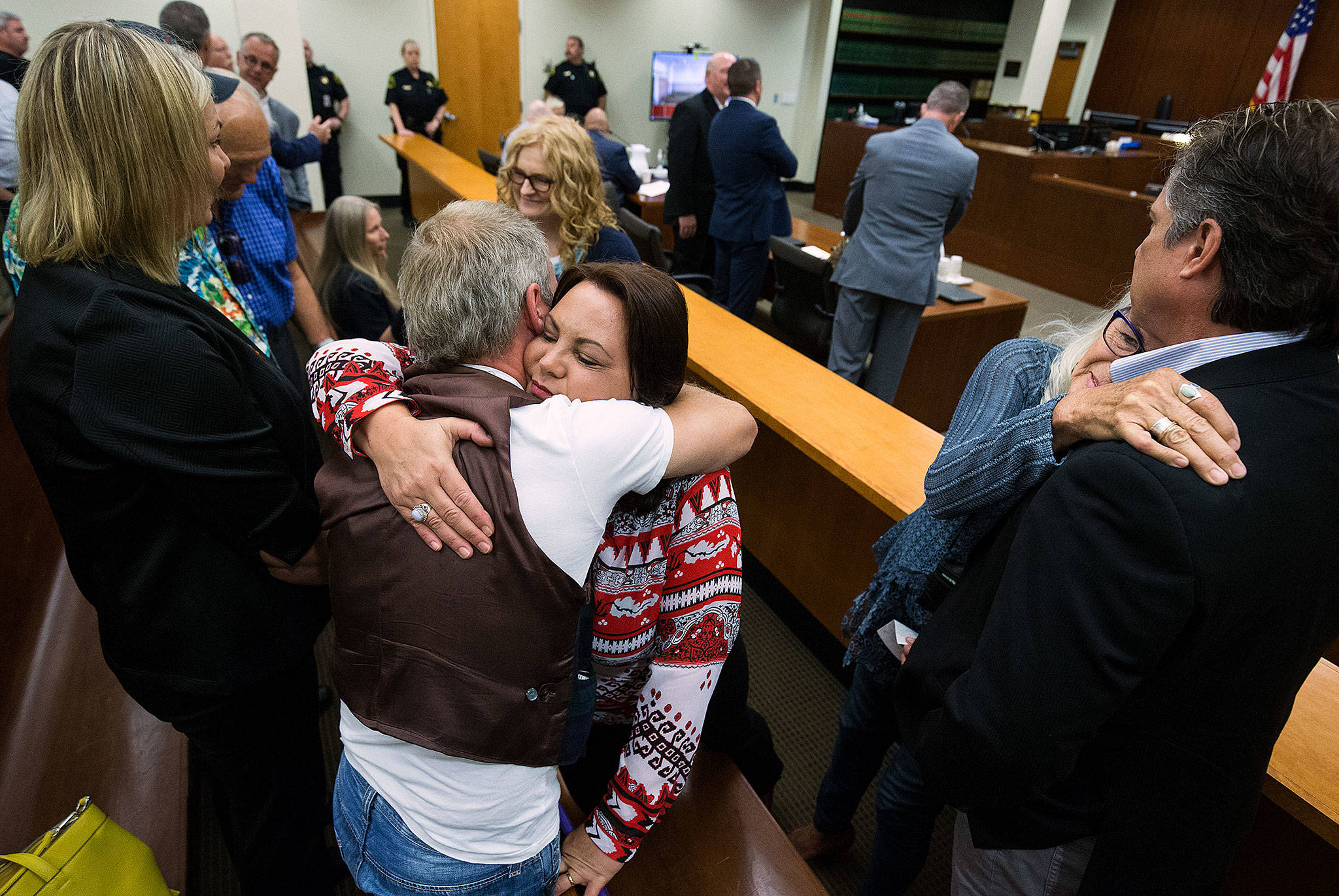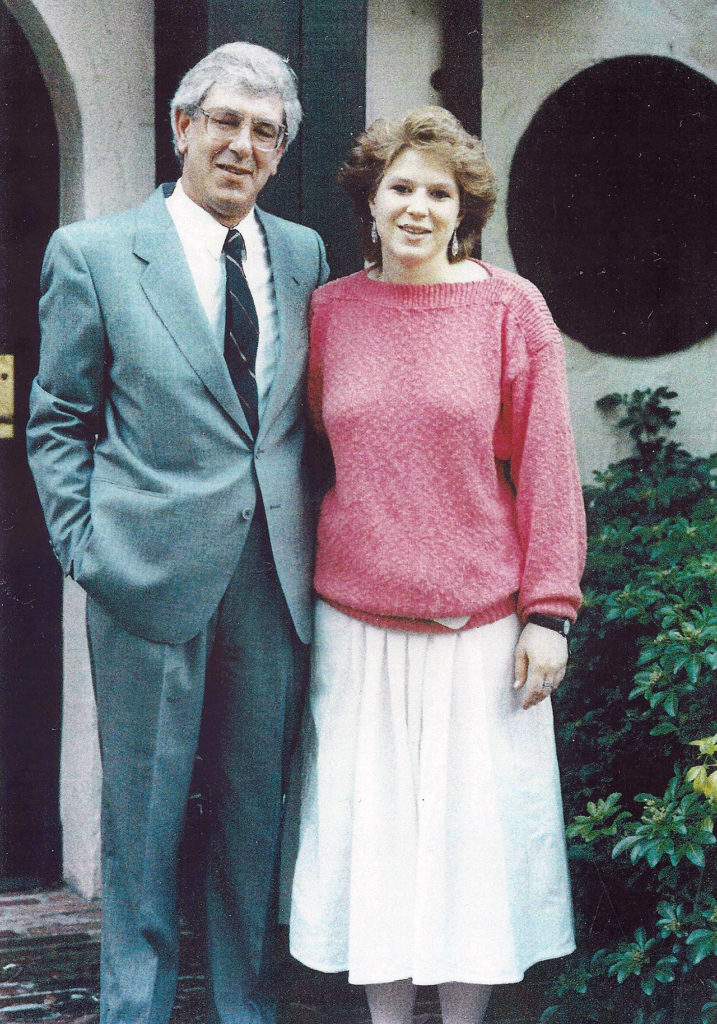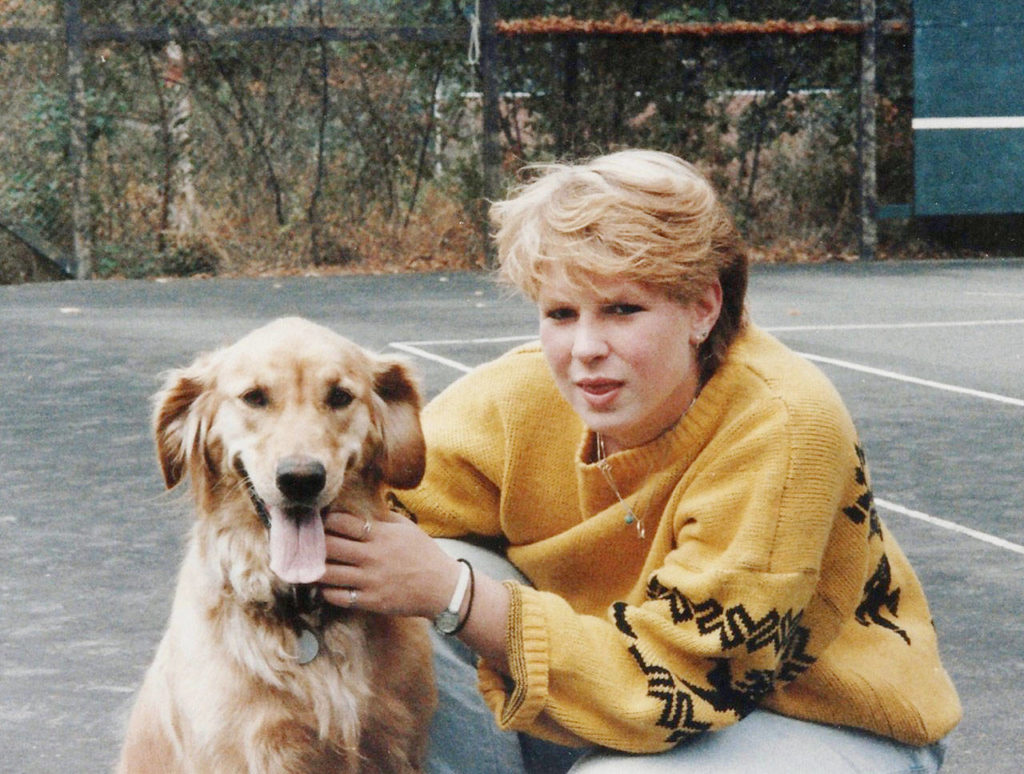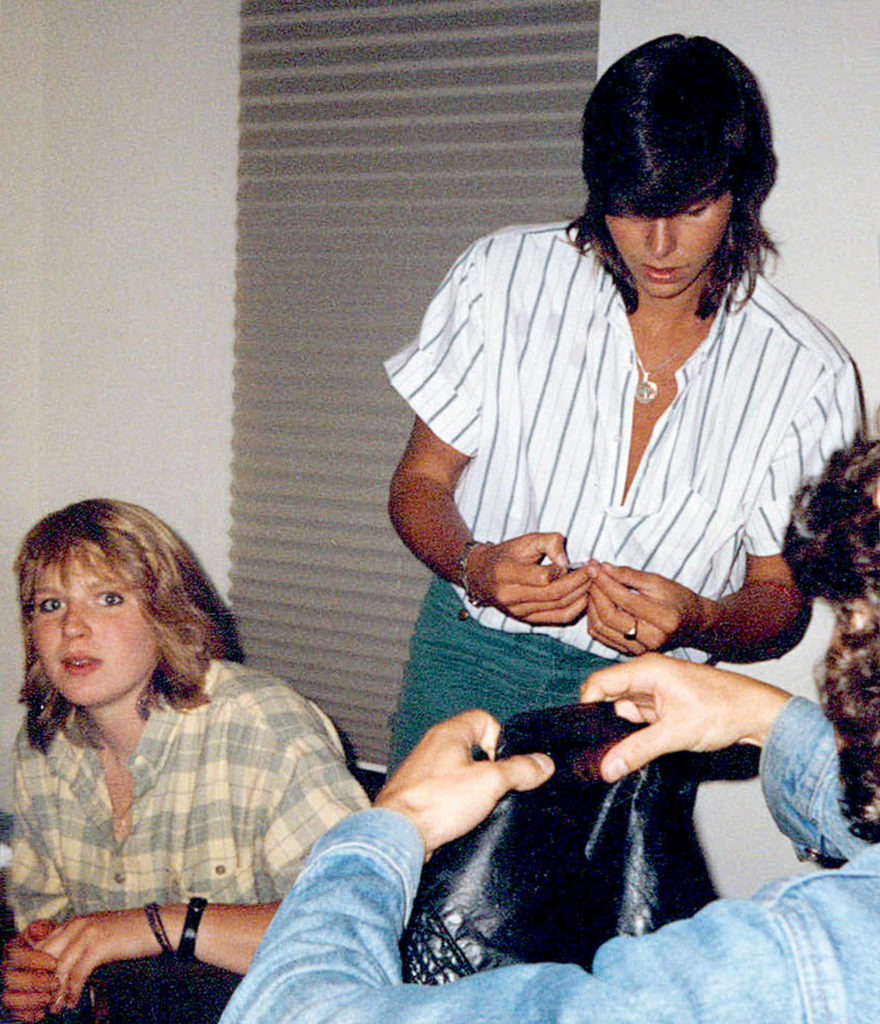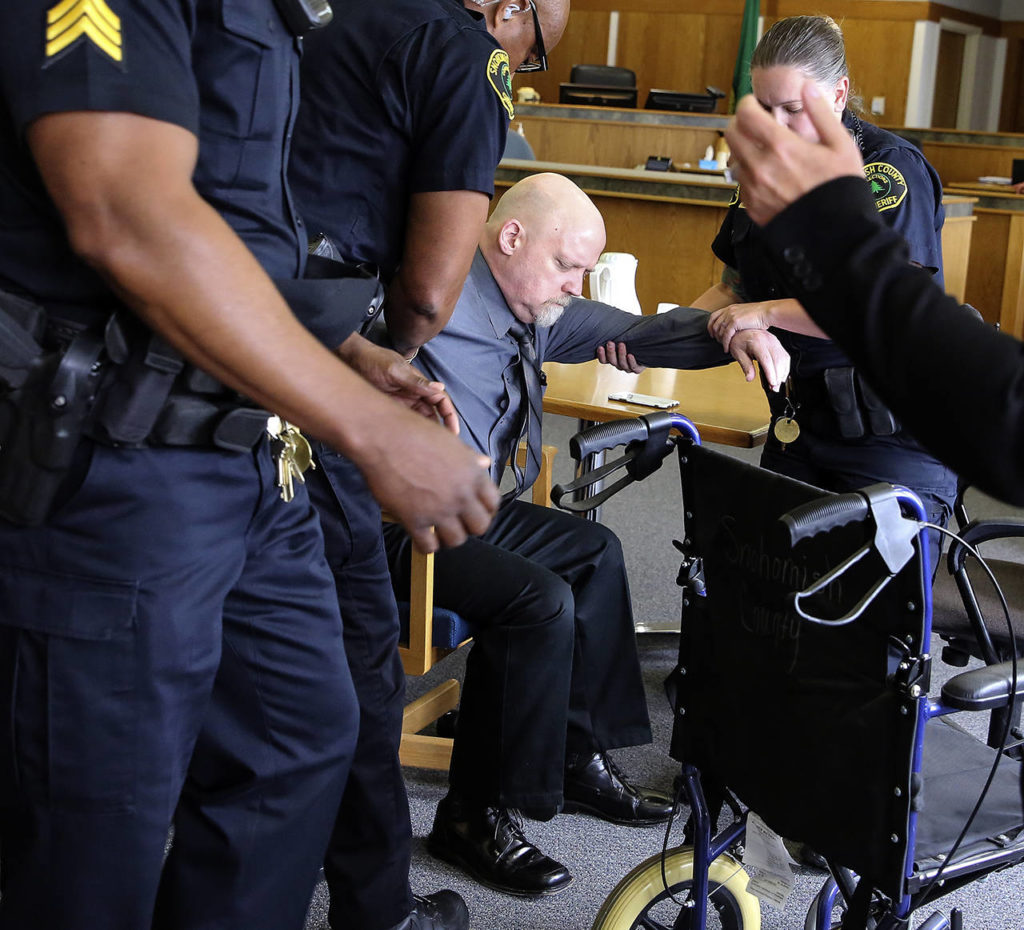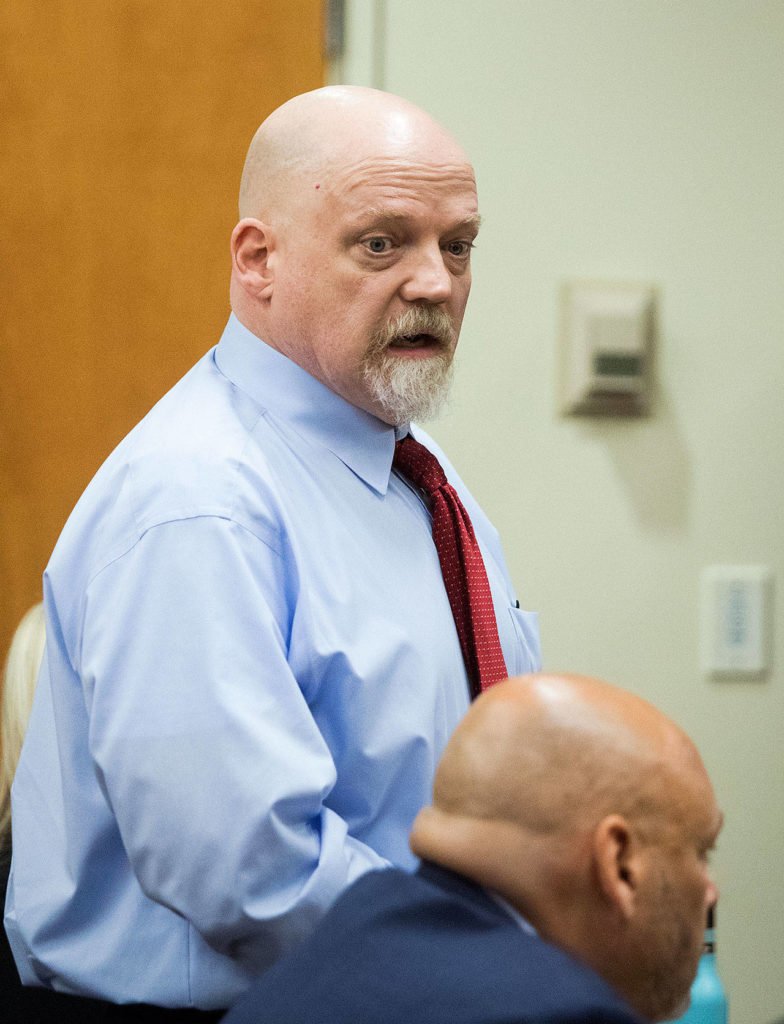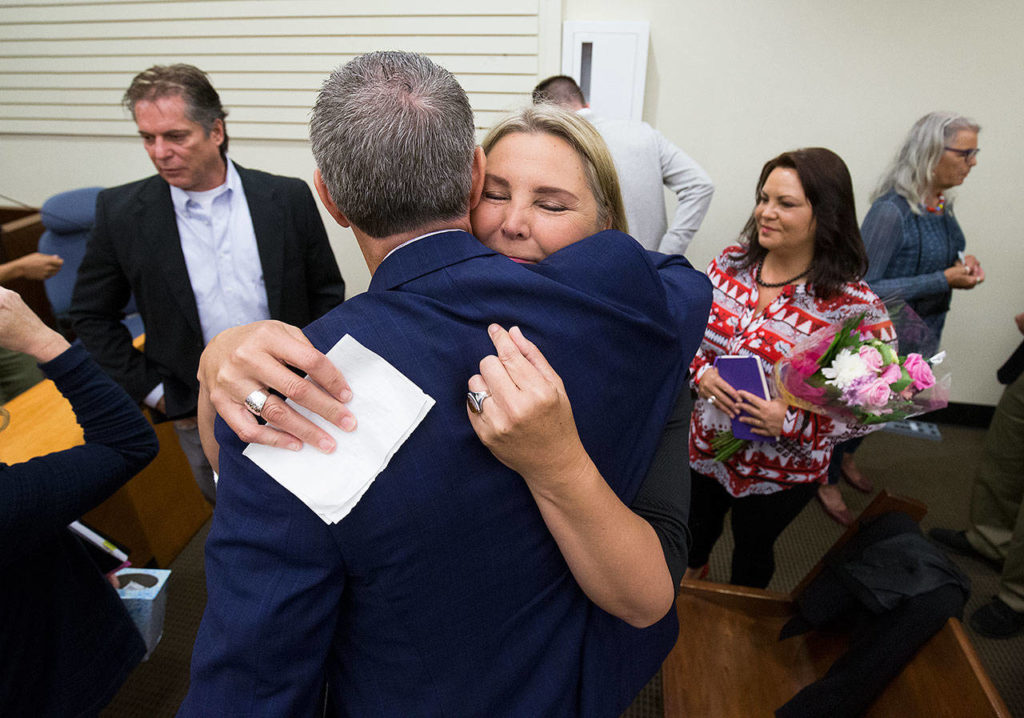EVERETT — It seemed their lives were just beginning on that chilly autumn day, when Jay Cook and Tanya Van Cuylenborg left their hometown for the last time.
Their killer evaded capture for three decades, until DNA revealed a suspect through his family tree, in what was a pioneering investigation.
On Wednesday, a Snohomish County judge sentenced William Talbott II to life in prison without parole for murdering the young Canadian couple in 1987.
The pair was killed on an overnight trip from Greater Victoria, British Columbia, to south Seattle. Baffling gaps remain in the timelines of the killings. In a trial last month, no one could say exactly when or why Cook, 20, had been beaten with rocks, strangled to death and dumped under a bridge south of Monroe. Van Cuylenborg, 18, was shot in the head. Her body was left off a roadside, in rural Skagit County.
A long-awaited break came in 2018, when a private forensic lab plugged crime scene DNA — from semen on a pair of pants — into a public ancestry bank, GEDMatch. Second cousins on both sides of Talbott’s family had shared genetic profiles in the database. The suspect’s family lines intersected in the marriage of a Woodinville couple. Talbott was their only son.
Two more tests confirmed his DNA matched the semen. Talbott, 56, maintains his innocence.
“The level of violence in this is something I cannot comprehend,” he told the courtroom Wednesday. “I’ve gone all my life as a very passive person. I’ve never raised my hand towards anybody.”
He said he’d never fired a handgun in his life.
Since last year, dozens of suspects have been arrested in cold cases across the United States, with the help of the new technique known as forensic genealogy. It has given police a groundbreaking new way to solve rape and murder cold cases. Privacy advocates, however, have serious misgivings about unchecked police handling of the technology.
In the landmark trial in Snohomish County, Talbott became the first defendant in such a case to go to trial by jury, and the first to be convicted.
On the day of his arrest, state law allowed two possible sentences for aggravated first-degree murder: life in prison or death. The state Supreme Court effectively abolished the death penalty, as Talbott awaited trial.
That left only one option for Superior Court Judge Linda Krese on Wednesday. She sentenced the defendant to two consecutive life terms.
The sentence brings with it a kind of satisfaction, wrote Van Cuylenborg’s best friend from high school, May Robson, in a letter to the judge.
“But that’s all I have, satisfaction, nothing more, nothing less,” Robson said in the letter. “The sorrow will remain in my heart for the rest of my life. I miss my friend Tanya.”
King of Hearts
Van Cuylenborg had graduated from Oak Bay High School that June, a few miles east of the docks, boutiques and charm of downtown Victoria.
She was a competent sailor on family trips; a casual guitarist whose favorite band, U2, had just released their first No. 1 record; and a bit overmatched as a tennis player, when she battled her brother in the court in their backyard on Vancouver Island.
She cared for many pets: cats, fish, gerbils and — after constant appeals to her mother — a beloved Golden Retriever, Tessa. One day she dreamed of working with animals, perhaps as a veterinarian.
But she wasn’t rushing to figure life out, to get a job and to get out of the house. She was saving for a trip to Holland, where she had family on her father’s side.
That summer she started to date Cook, who was 6-foot-4, broad-shouldered, left-handed. He’d worked on a fishing boat and in a pizza restaurant, picked up bass guitar and loved boating with his family, too.
Cook invited his girlfriend to come to Seattle with him on Nov. 18, 1987. He needed to pick up a $750 money order for his father’s business.
They crossed on the Coho ferry from Victoria to Port Angeles, missed the exit to the Hood Canal Bridge, rerouted the bronze Ford van through Allyn en route to Bremerton, then boarded a ferry bound for Seattle.
The boat docked before midnight. They planned to sleep in a parking lot outside Gensco, the appliance supply store in SoDo. They never arrived.
In post-trial interviews with The Daily Herald, jurors said they believe the pair had most likely been killed in the eight hours or so after they arrived in Seattle.
Six days later, a passerby found a young woman’s half-naked body in wet leaves off Parson Creek Road, a wooded drive near Alger. Van Cuylenborg had been shot in the back of the head with a .380-caliber gun. Investigators swabbed semen from her body. Talbott’s defense argued the sexual contact had been consensual, not rape.
The next day, Van Cuylenborg’s ID, a box of .380-caliber ammunition and gloves were found under the porch of a Bellingham bar. Around the corner sat the van, near a Greyhound bus station. The unused money order was still inside, along with a pair of semen-stained pants and a blood-streaked comforter.
It was Thanksgiving when a pheasant hunter’s dog uncovered Cook’s body under a blue blanket in tall grass along the approach to a bridge over the Snoqualmie River. Tissue and a pack of Camel Lights were shoved down his throat. He’d been strangled to death with twine tied onto dog collars.
At all three of the crime scenes, the killer left behind white zip ties. A Minolta camera, a ski jacket and a backpack were missing from the van.
Years of exhaustive investigation bore no fruit.
The Snohomish County Sheriff’s Office featured the couple in a deck of playing cards that were handed out to inmates, in hopes of conjuring new tips in 52 cold cases. Their names were on the King of Hearts.
Van Cuylenborg’s only sibling, John, a civil attorney in Canada, struggled to find words this month for how the senseless death deeply wounded his family.
“My parents were never the same after Tanya’s murder,” John Van Cuylenborg wrote to the judge. “After a few years they were able to put on a facade most days that they were continuing on, but it did not take much to scratch through their thin veneer to expose their raw pain, shock at the cruelty of the world, and their lack of will to carry on.”
For years John Van Cuylenborg could not enjoy music or movies, he wrote, because happiness seemed like a betrayal of his sister’s memory.
Who is Bill Talbott?
Detective Jim Scharf handcuffed Talbott in May 2018, when the trucker from SeaTac returned from one of his routes. Meanwhile, investigators scattered across the region waited outside the homes of his family members, to knock on doors for interviews, before anyone else could influence them.
Seven women and five men on the jury heard little about Talbott’s background — except that he was a blue collar guy who grew up near Woodinville, liked to bowl and knew a thing or two about cameras.
Several of Talbott’s friends penned stunned letters in July 2018, asking a judge to reduce his bail. The Bill Talbott they knew was no killer.
“In the time I have known Bill, he has always been a loyal, caring, loving and unselfish person,” one friend wrote.
“I still do not believe this man could of done this terrible crime or even participated in any way,” another wrote.
“Bill is a very respectful man and has a heart of gold,” wrote a third family friend.
None of them knew Talbott in the ’80s. Court records show a misdemeanor assault conviction in 1985. He was required to seek anger management counseling. He skipped court dates in 1986. After being booked into jail for an overdue $240 fine in 1988, he finally paid off his legal fees.
At the time of the killings, Talbott was 24.
Unflattering allegations about his past were outlined in court papers in June, in response to claims made by at least one former roommate, Michael Seat. At trial, the defense questioned Seat’s credibility, and some of his memories conflicted in different retellings. A defense motion sought to prevent Seat from making statements that could prejudice a jury, if the state had no supporting evidence.
The defense listed specific claims point-by-point: that Seat said he saw a blue blanket in Talbott’s home and car in the 1980s, like the one found on Cook; that Talbott had a tumultuous relationship with his family, including a fight where he was accused of breaking a sister’s arm; that Talbott had only one girlfriend, who left him when he ran out of money; that Talbott was like Dr. Jekyll and Mr. Hyde when he drank alcohol; that Talbott was “a scammer, idiot and good at bs-ing;” that he would hitchhike; and that he rode Greyhound buses. Seat also claimed he saw a bronze van outside Talbott’s house in fall 1987, on a misty day.
But the jury did not hear any of that.
Instead the former roommate’s testimony centered on a time Talbott took photos with him along a riverbank south of Monroe, in the general area where Cook’s body was found.
Other evidence was not shown to the jury.
A zip tie in the van tested positive for Talbott’s DNA, a revelation that didn’t become public until after the trial. Prosecutors did not tell jurors about the last-minute tests, to avoid a potential problem on appeal.
The defendant’s only words in the trial came when the jury delivered a verdict to a packed courtroom: guilty, on two counts of aggravated murder.
“No,” Talbott rasped. “I didn’t do it.”
He slumped over in an apparent state of shock. Jail guards pushed him out of courtroom in a wheelchair.
Sentencing
A month later, Talbott entered a courtroom standing, in a pale blue dress shirt. He took his seat and glanced behind him at four long benches full of people. National media followed the case, and journalists from Canada attended the hearing Wednesday.
Judge Krese dismissed last-ditch efforts by the defense for a new trial.
Defense attorney Jon Scott had argued deputy prosecutor Matt Baldock’s final arguments played too much on jurors’ emotions, rather than focusing on facts and evidence. Scott said the state’s theory rested on an inference that Talbott raped Van Cuylenborg, “and because he raped her, he did all these other things.” He argued the evidence didn’t back that up.
The judge rejected the argument. The defense, she said, was inviting the court to look at each piece of evidence “in a vacuum,” rather than in its broader context.
Scott also contended that jurors ignored the judge’s instructions in deliberations. Krese had denied a jury request for a map of Western Washington, for example. So a juror drew a map from memory to retrace the couple’s route. Krese didn’t find that improper.
The judge proceeded to sentencing around 10:40 a.m.
Cook’s sister Laura Baanstra spoke first.
“How can I stand up here and talk about being a victim,” she said, “when I have so much love coming in from all sides?”
Baanstra thanked God that her brother’s killer was off the street. Yet for the family of Jay Cook, the past year reopened wounds that had, as much as possible, healed long ago.
Jay Cook’s mother, Lee, believes her son pulled over to help a stranger in the cold, because that’s the kind of person he was. She believes Talbott took advantage of his kindness.
“Jay would’ve picked anyone up, on a night like that,” Lee Cook said.
Jay Cook’s sister, Kelly, recalled how the defense said, in an opening statement, that Talbott led an unremarkable life.
Her brother and his girlfriend, she said, had remarkable lives ahead of them.
“It seems to me the only remarkable thing (Talbott) ever did … was to take,” she said. “And what he took was the lives of two very young people.”
No one spoke in court for Talbott, except for his attorney and the defendant himself.
“I have not seen a hint of the cruelty necessary to commit these crimes,” Scott said.
Talbott’s voice cracked with emotion as he addressed the judge. He referenced a moment in the trial when his defense tried to bring up a tip that law enforcement received in the 1990s.
“The state says that all the answers here have been answered,” he said. “Far from it. What a perfect example, is something you did not allow the jury to hear. Early in the 1990s, someone came forward that apparently had a great deal of information about Jay Cook’s death. Yet you did not allow the jury to hear it. You did not hear who it was that came forward. That’s an unanswered question.”
Talbott turned to detective Scharf.
“That’s your fault,” the defendant said. “I’m sorry, but — this is just beyond my comprehension, being charged with something of this nature. I do have sympathy for the family.”
John Van Cuylenborg has been convinced of Talbott’s guilt since the arrest. He cannot see an innocent explanation for the evidence. Talbott’s speech did nothing to sway that belief.
“I just can’t take that any other way than a sort of self-serving plea, unless he’s willing to explain what his involvement was — because he was clearly with these kids, the last few hours of their lives,” Tanya’s brother said.
Out of eight days of testimony, only a few minutes of the trial focused on how the suspect was initially identified, through forensic genealogy. But that is the piece that garnered international headlines.
John Van Cuylenborg views the technology as not only a great way to solve cases, but a massive deterrent to stop murders before they happen.
“Society really owes an obligation to these kids, and to itself, to make use of this tool,” he said.
If there need to be rules about how police can use forensic genealogy, that’s OK, Tanya’s brother said.
“We’d be very much the worse off if we don’t take the opportunity to use this technology to make our society a safer place for everyone,” he said.
Today, John lives minutes away from his sister’s best friend, May Robson, who often visits his mother in a care home in Greater Victoria. Since kindergarten, their kids have attended the same schools.
“This,” Robson wrote, “has kept Tanya alive in my heart.”
Caleb Hutton: 425-339-3454; chutton@heraldnet.com. Twitter: @snocaleb.
Talk to us
> Give us your news tips.
> Send us a letter to the editor.
> More Herald contact information.
